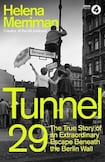
Germans have a saying that you can find the best stories lying around on the streets. Helena Merriman’s lively new book, Tunnel 29, proves that sometimes the best yarns lie beneath.
Take Berlin’s Schönholzerstrasse: like most locals, an office colleague of mine had no idea of its notoriety when he moved into number seven many years ago. Only in 2009, when a plaque was attached to the facade, did he learn the full story of the building’s cellar. From here in September 1962, 29 people from the communist East vanished here into a tunnel beneath the Berlin Wall and emerged, 12 minutes and 140 metres later, in West Berlin.
It was one of at least 75 escape tunnels dug under the wall, erected around West Berlin 60 years ago this year.
At 1am on August 13th, 1961, East German leader Walter Ulbricht gave a secret order for soldiers to unfurl spools of barbed wire to divide the city. It took just five appalling hours to erect a demarcation line – later reinforced with concrete panels, tank traps and self-firing machine guns – that severed families and claimed at least 140 lives over the next 28 years.
Merriman humanises events others often gloss over, details which are crucial for understanding the shift from hot to cold war
Human history is filled with walls, but the Berlin Wall was special: designed not to keep people out, but keep easterners in – away from an escape hatch to the capitalist west via West Berlin. Berlin’s wall museum has a section dedicated to escape attempts, some spectacularly successful, many tragic failures.
Of the 75 attempts to go under, rather than over, the wall, just 19 were successful, and around 300 people made it to the west.
Merriman’s book, based on her popular BBC podcast, is in fact the story of two tunnels, one of which went wrong. It gets off to a flying start, as Merriman takes readers through the fall of the Nazis and the rise of Stalin’s marionettes in East Berlin – all through the eyes of her main protagonist Joachim Rudolph.
Through his eyes, first as a six year-old fleeing the Red Army with his family and later as a teenager in the ruins of Berlin, Merriman humanises events others often gloss over, details which are crucial for understanding the shift from hot to cold war. She makes a coherent narrative out of the chaos and spares the reader nothing about the post-war years in Germany: the rapes, the suicides, the thefts.
Once the barrier is erected, Joachim flees East Berlin at night but is drawn into a West Berlin student collective dedicated to digging people out. From this point on the book shifts to a looser, laconic style.
Chapter 14 opens with US president John F Kennedy, still unaware of the Berlin Wall, lounging on a boat off Cape Cod: “The water is calm and so is he”.
An NBC television executive, whose camera team are filming and subsidising the tunnel dig, hurries through Paris “shiny shoes clicking on the pavement”. At least two characters move in a “cat-like” fashion, another “sashays” through Tempelhof Airport. In a tale that trades on authenticity, Merriman’s style will work for some but will irritate others.
With a team of German-speaking fixers and translators, the BBC journalist has herself done some remarkable digging. That pays off in the book’s second half and the tale of another, failed tunnel, an imprisoned digger and a Stasi informer inside the student rescue group.
Tunnel 29 is a quick, arresting read that brings to life recent history and will appeal to young readers, perhaps because it often reads like a story treatment for a Netflix series
Merriman’s brisk, present-tense approach rattles along and will keep readers hooked. The flip side is a narrow focus and lack of differentiation that, occasionally, turns the human tragedy of German division into podcast pantomime.
The Stasi was everywhere, we are told, forcing all easterners into a terrible, binary choice: collaborator or dissident. The more complex truth is the largest group was an army of conformists, who don’t feature in this book, but whose sullen silence helped keep East Germany going and its wall up.
No doubt unintentionally, her enthusiastic narrative gives the Stasi a dark, malevolent glamour that would flatter its failed spy chiefs. Merriman’s Stasi sees everything and knows everything, yet somehow missed Tunnel 29 and even the events that lead to its own collapse in 1990.
At 279 well-spaced pages, with short chapters, Tunnel 29 is a quick, arresting read that brings to life recent history and will appeal to young readers, perhaps because it often reads like a story treatment for a Netflix series.
The price for that approach is that, for all of her impressive research and real empathy, the real people of Tunnel 29 and their extraordinary experiences never quite exist independently of Merriman. They are her protagonists in her story.
Derek Scally is Irish Times Berlin Correspondent and author of The Best Catholics in the World
Tunnel 29 by Helena Merriman is published by Hodder












